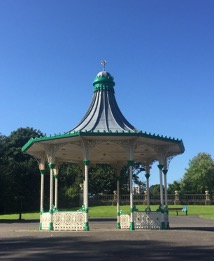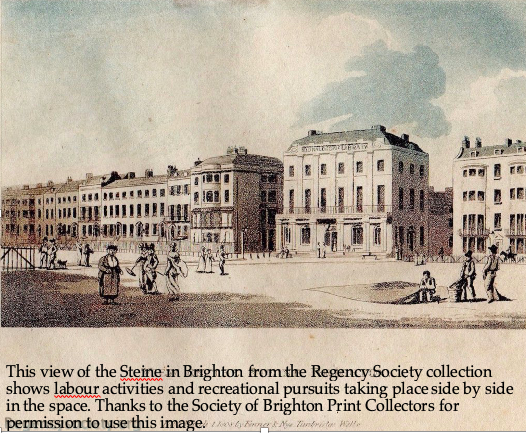Historic Perspectives on Urban Commons
Experiences of Urban Green Spaces: Historic Perspectives on the Urban Common
It is coming up for two years since we held the first workshop for our AHRC-funded project 'Wastes and Strays: The Past, Present and Future of Urban Commons'. So much has, of course, changed since then. Our project has been severely disrupted by the pandemic. Yet, there is now a much greater awareness among the public of the importance of open green spaces to our physical and mental health. In this context, urban commons (along with other green spaces, such as parks) are recognised as being of particular value in providing these benefits to city-dwellers, many of whom have no garden of their own and who may live many miles from the countryside. Consequently, discussion about the past, present and future of urban commons seems more timely than ever.
So it was with some excitement that we planned our delayed second and third workshops as two webinars on 'Experiences of Urban Green Spaces'. The first offered an 'Historical Perspective on the Urban Common'. The second focused on 'Present Uses of Urban Commons'. This blogpost will summarise the first of these two webinars, a follow-up blogpost will deal with the second.
The first webinar opened, after a brief introduction, with an excellent talk 'From open space to public space: the idea of the right to air and recreation'by Dr Katrina Navickas, Reader in History at the University of Hertfordshire. Dr Navickas began by highlighting the fact that there is a persistent tension between how common land, and the rights associated with it, are seen in the public imagination and their official legal status. In many cases, commons are not publicly owned at all, but instead they are private land over which certain people have been accorded rights to specific uses (for example grazing) and the access to exercise those rights.
Dr Navickas went on to point out that further ambiguity exists in the case of urban commons, which since the nineteenth century have had two dominant - but quite distinctive and sometimes conflicting - uses: first, as agrarian pastureland; and, second, as recreation grounds. The emergence of the latter use in the nineteenth century was particularly controversial. This was partly because the right to air and exercise was not at that time an explicit statutory right. This was only established in the Law of Property Act of 1925. At the same time, the provision of open space for recreation was closely tied to attempts on the part of Victorian authorities and elites to constrain and police the behaviour of working people. This was reflected in the rise of the Victorian public parks movement, which saw calls for the conversion of various English urban commons into public parks - the layout and nature of which made them easier to police. It also inflected the establishment of the Commons Preservation Society in 1865, and its early focus and direction. As Dr Navickas explained, these efforts were - at least in part - motivated by the desire to obstruct the organisation of political meetings.

Then bandstand in Leazes Park Newcastle. The park was built, as part of the Victorian public parks movement, on Castle Leazes part of Newcastle's urban common. Wastes and Strays. 1 September 2020. Image by Rachel Hammersley.
The Chartists frequently held meetings on common land, a trend that was continued by later parliamentary reformers and other opposition groups. At the beginning of the nineteenth century such meetings often took place on town moors, with many being short affairs that workers could attend during their lunch hour. However, as town commons were increasingly built over, protestors in many areas found themselves either confined to small spaces or forced to move out to more distant rural commons. This change also prompted a shift in the timing and duration of the meetings. Increasingly, they were scheduled for Sundays or Mondays (traditional holidays) and became whole day events - a day out rather than just a political meeting.
Dr Navickas ended her talk by noting that the tensions and issues surrounding urban commons survive to this day. This has been reflected most recently in the conflict over protests on Clapham Common in March 2021. (The slides from Dr Navickas's talk are available here: https://research.ncl.ac.uk/wastesandstrays/wastesandstraysblog/)
After Dr Navickas's talk we divided into four break-out groups, each focusing on a different theme, with the members of each group having been provided in advance with a few short extracts from some of the sources we have discovered in the course of our research.

A sign promoting inclusivity in The Levels playground, Brighton. Wastes and Strays. 17th August 2020. Image by Siobhan O'Neill.
Those focusing on the theme Assembly on the commons noted how difficult it is for historians to unpick the motivations behind large-scale popular protest, and the fact that different motives (political action, community building, entertainment) were probably intertwined. It was acknowledged that the rise in large mass meetings was linked to the widening of the franchise with the nineteenth-century Reform Acts. Furthermore, that an element of spectacle was always built into these events. Protesters often processed through the town to the meeting and use was made of music, banners, and sashes to indicate the cause and key issues to bystanders, elements that remain crucial to protests today. It was also observed that not all crowds are the same. The gathering on Valley Gardens to celebrate the Prince Regent's visit to Brighton in 1827 was very different from the demonstrations by local pitmen and those calling for the release of Irish prisoners on Newcastle's Town Moor in 1850 and 1872 respectively. It was noted that the question of who organised the gathering was key (particularly, whether it was organised by the authorities or by opposition movements), but it was also acknowledged that official gatherings could easily be subverted by a crowd.
The group considering Fringe Society was particularly interested in the connection their sources drew between marginal space and marginal people. The question of who has the authority over urban green space is a pertinent one, and is linked to assumptions about how particular spaces should be used. In addition to bylaws trying to stop the most exploited in society from using these spaces, there are also unwritten codes of behaviour. However, it was noted by the group that these codes of behaviour could change depending on the time of day or the season and that they could also be challenged or subverted. Siobhan O'Neill, who is working on the project and was a member of this group, observed that in more hidden areas of her local common, marginal groups such as gay men or homeless people claimed the space as their own by marking areas with white pebbles or hanging up clothes. There are broader issues here about the gradual regulation of space over time and ongoing conflicts and tensions between different users of urban green spaces.

The group tasked with considering urban commons as Spaces of labour explored how both the work taking place on commons and the type of people conducting that work has changed over time. Labour on the commons might originally have centred on the grazing of animals and extraction of mineral resources, but today the focus is instead on recreation, meaning that although we treated them separately in our groups, labour and recreation are intimately intertwined. The shift towards commons being used for recreation expanded the types of labour taking place on them to incorporate things like operating fairground rides, performing in a circus, serving burgers from a van and even prostitution. This expansion of activities meant that many of those who now rely on common land for their subsistence and survival are not actually endowed with historic rights to use that land. Moreover, neither the use rights, nor the services required to make possible those activities, are enshrined in legal terms. Furthermore, it was noted that such activities challenge the notion of commons as egalitarian spaces, with hierarchies based on role, status, class and gender frequently on display.
People taking air and exercise on Mousehold Heath. N. Bucks, Mousehold Heath. Thanks to the Norfolk and Norwich Millennium Library for permission to use this image.
The group exploring urban commons as Spaces of recreation made similar observations, noting the existence of hierarchies of recreational use and the fact that conflict has frequently arisen over the practice of specific leisure pursuits on commons. Whether or not a particular activity is deemed a nuisance may depend on precisely where on an urban common it takes place and whether it is appropriate to the time of day or season of the year. Who defines what constitutes a nuisance and manages the space is also crucial. The group felt that bylaws, though frequently used in these contexts, are not necessarily effective means of managing behaviour and balancing different uses and needs. The group was more interested in understanding how people organise spaces for themselves and the potential for self-management. It was suggested that this perhaps works best if the use of a space is allowed to grow and develop over time in response to demand. One group member drew the analogy with a swimming pool where the desire for some to swim seriously and others to play might lead to the demarcation of space through the introduction of swimming lanes or to rules about who can use the pool at different times of day.

A sign promoting inclusivity in The Levels playground, Brighton. Wastes and Strays. 17th August 2020. Image by Siobhan O'Neill.
Although the sources each group examined were different, a number of common themes emerged in the discussions. In the past as now, the question of who is responsible for the management of urban commons, and who has control over the activities that can and cannot take place there, is particularly significant. Though understood as common land available to all, the reality is that most commons are owned and managed either by the local city council or by an independent body or, perhaps most often, by a complex historic relationship between the two. In addition to tensions between the relevant authorities and local people, our discussions made clear that conflicts also arise among different user groups, each having its own understanding of what constitutes appropriate or inappropriate behaviour in the space. Such tensions are deep-rooted and have occurred over many years. We might even go so far as to say that they are inevitable, inherent in the very notion of open or common space. That does not mean, however, that there is no value in thinking carefully about how such tensions are managed, paying attention to different voices, and exploring how conflicting uses might be accommodated. Given what the last year has revealed to us about the importance of urban green space, we owe it to future generations to learn lessons from the past and to think creatively about how we can continue to share and enjoy these valuable urban commons in ways that are fair and sustainable.
Professor Rachel Hammersley, May 2021










